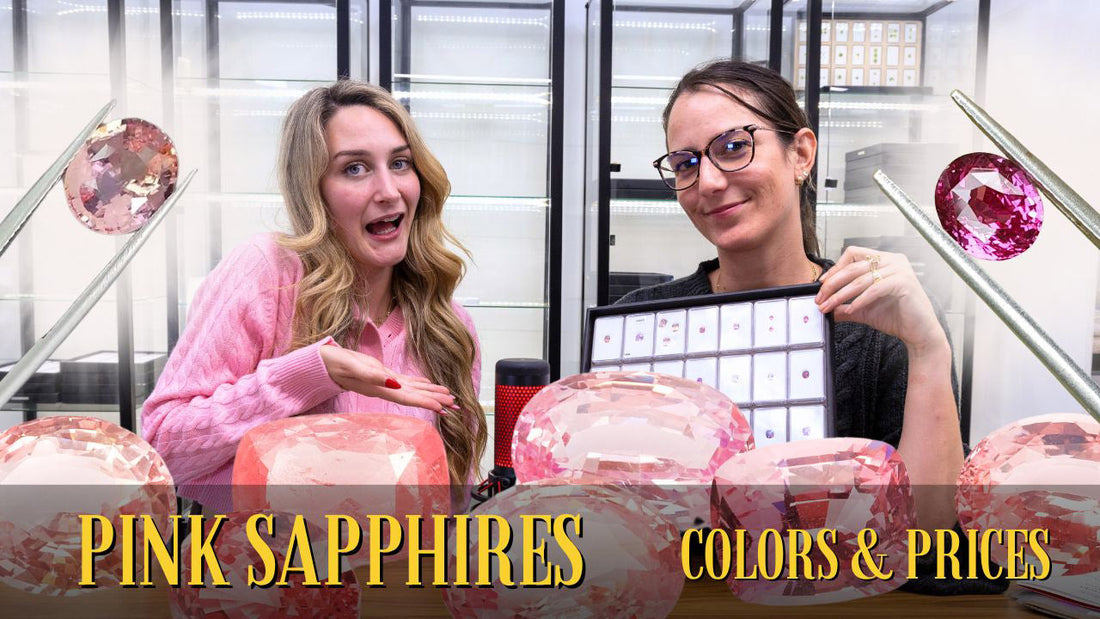Shop our sapphires from our curated gemstone collection here
Pink Sapphire Overview
If you like the color pink, you'll love Pink Sapphire. Pink Sapphires come in a wide range of colors, from hot pink, purplish pink, and very light pink to raspberry.

Color Range
Pink sapphires come in a wide range of colors. Like any sapphire, they vary in saturation and can sometimes have a light mix of two colors. Our selection of stones ranges from more purplish or purply pink to peachy pink, as well as the rare Padparadscha, one of the rarest sapphires.
Pink sapphires follow typical gemstone pricing rules: the lighter the color, the cheaper the stone; the more saturated the color, the more expensive it becomes—peaking with hot pink sapphires, which are the most valuable. Beyond that point, as the colors shift to off-shades or darker tones, the price starts to drop due to lower demand.
When sapphires exhibit a hint of orange and pink, they can be classified as Padparadscha sapphires. These are a rarity and have their own prestige but are often grouped with pink sapphires. To learn more about Padparadscha, one of the rarest gemstones, check out our dedicated blog!


Treatment and Clarity
Pink sapphires typically undergo standard treatments such as heat treatments and beryllium. Like most sapphires, pink sapphires are treated at high temperatures for long durations to reduce inclusions and enhance color. There are also low-temperature-treated pink sapphires, which are harder to detect because the process is closer to Earth's natural temperatures. However, labs can identify this and will include it in a certificate, stating whether the stone underwent low or high heat treatment.
Low-heat treatment is generally considered better, as long as it's disclosed. It preserves the "soul" of the stone, including any natural inclusions present from the beginning. After low-heat treatment, inclusions may still be visible, but the color could improve slightly.


Cut
The best investment in a quality stone is its cut. The cut is crucial because it determines how much the gem will sparkle. A poor-quality cut can be easily identified by facets that don't align, stones that lack symmetry, or a table (the top facet of the stone) that is cut either too large or too small. All these issues can affect and dull the stone's sparkle, as the alignment and proportion of the facets are what allow light to properly bounce throughout the stone, hitting each facet and creating that shimmering, attractive sparkle.


Pink Sapphires vs. Rubies
An interesting fact about pink sapphires is that they are essentially light rubies. Pink Sapphires are an affordable option in comparison. Sapphires and rubies are both part of the corundum family. When a stone has a high concentration of chromium, it appears red. Lighter concentrations result in pink hues, which are classified as pink sapphires. Some dealers may sell pink sapphires as rubies, charging a few thousand dollars more per carat. This is because rubies are rarer, and their price increases due to the high levels of chromium required to produce a deep, rich red color. If you negotiate, you may be able to get a better price by purchasing a pink sapphire instead of a ruby.
Pricing:
The following prices are estimates based on the current market value at the time this article was posted. As the sapphire carat weight increases, the prices may grow exponentially.
Pink Sapphire:
- medium-light pink 1-1.5ct range =1200-3k
- medium to hot pink: 1-1.5ct range = 2500-5k
Padparadscha Sapphire:
- 2 carats: $20,000 (high rarity and prestige)
If you are looking for more affordable options with a similar look, garnets and rhodolite garnets offer pink alternatives at a lower price compared to sapphires


